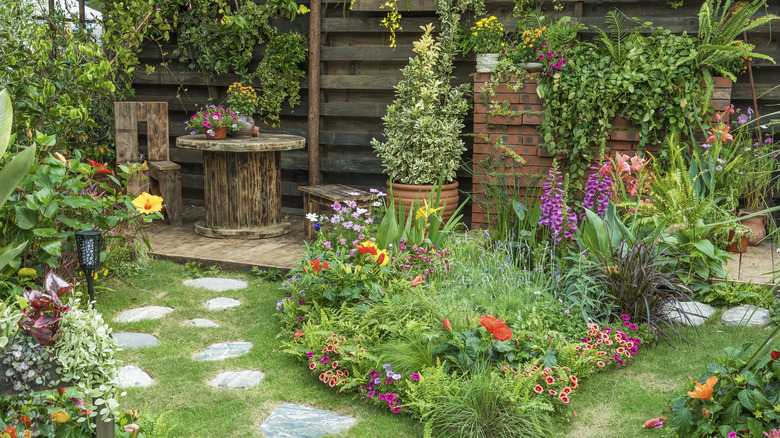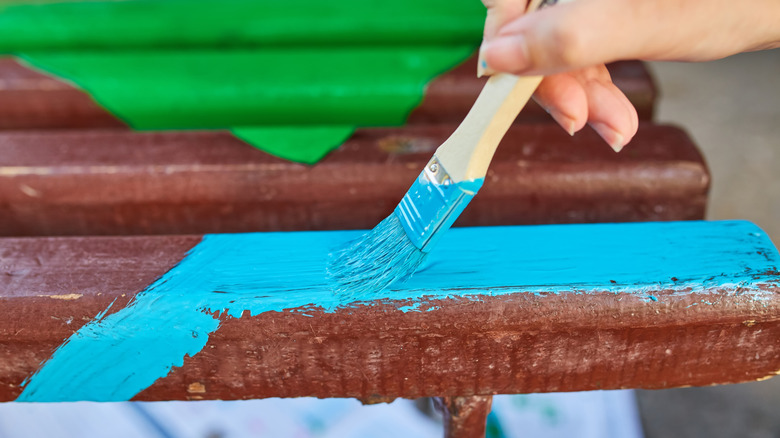Make An Eight Foot Long Garden Bench For An Affordable Price
We may receive a commission on purchases made from links.
Upgrading your home on a budget starts with finding the perfect pieces of furniture for each space. Even a simple thing like a well-placed bench can make a world of difference in a garden that just looks "okay" at first glance. They can go on a porch, patio, or in a small nook in the backyard. They provide a helpful place to enjoy nature, and a charming or rustic bench can also help add another decorative layer to an outdoor space. But why spend hundreds of dollars on a garden bench when you can make your own without spending over $50? That's right. You can build a suitable garden bench using only five 8-foot wood panels and a can of wood stain.
Designing this bench will only take a few hours and is a great weekend project. In addition to the panels and stain, you'll also need construction screws, a drill, measuring tape, and a miter saw if you don't already have one. You can also use a Skil circular saw with a table vice. Home Depot has 2 by 4-inch 8-foot wood panels for about $4.18 each. You can expect to pay roughly $10 each for the measuring tape and a box of Grip-Rite construction screws. A can of wood stain will cost around the same amount, and depending on how many coats you want, it may be best to buy two. The cool thing about this easy DIY is that you can use this basic design to further style the bench in various ways if you want.
Steps to build a garden bench from five 8-foot wood panels
Kick things off by first measuring and cutting two of your five 8-foot wood panels for the project. Set the other three aside for now. Cut one into four separate pieces, each 14 3/4 inches long. Then cut it again into four pieces that are 9 inches long each. Take the second panel and make the same cuts. With the cut pieces lying on the floor, take two 14 3/4 pieces and two 9-inch pieces and place them together, creating a square. This will be the bench's legs. Position the longer pieces as the sides of the square, and the 9-inch pieces as the top and bottom. When positioning the bottom 9-inch piece, leave about an inch of space from the bottom of the 14 3/4 piece — this will create feet for the legs.
Next, create pilot holes in the top and lower sections of the outer-facing side of both 14 3/4 pieces, and then fasten them to the 9-inch pieces with your screws. Then, line up two of the uncut panels closely together on the floor and place a leg flush on the top of both ends. Secure the legs by drilling screws into the 9-inch piece. Next, lift the bench and place the last panel in the middle of the other two, beneath the feet. Ensure that it's centered, then secure it to both legs. Then, take the other two bench legs and secure them to the bench, spacing them evenly in the middle. Add any finishing touches, such as sanding, wood filler, and wood stain, to the bench.
Customizing your DIY wooden garden bench
The wood base of this bench is what makes it so affordable, and buying decent-quality wood panels can keep your wood project from looking cheap. Upgrading the wood to a slightly better quality is always an option if you prefer not to stain or paint the bench. And with many woods, chances are it'll still be less expensive than other construction materials such as metal or concrete. But if the prices are too steep, you can always just choose a good stain to get the wood grain look you desire.
Also, consider adding extra elements to the wooden frame for more flair. For example, you can add a couple of arms to the bench if you can find pieces of wrought iron for cheap at a local flea market or junk sale. You can also upgrade the bench with reclaimed wood pieces, giving it more character by incorporating legs made of distressed wood. And painting the bench can be a simple way to add more color to your garden.
Consider going with a soft blue, sunflower yellow, or even a pale orange to help the bench stand out among the greenery. Perhaps create your own stencils and cover the bench with your favorite quotes or one-liners. Layer the bench with a few decorative flowers or vines on its seat and back as the seasons change. A few orange or red flowers (or leaves) to complement the fall and white or yellow blooms to welcome springtime can help give your garden a bit of whimsical spunk.

